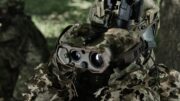A wave of panic in the households in February of this sad year: the word nuclear is added to the words that accompany the debates on the war in Ukraine. A madness! 30 years after the end of the Cold War, 30 years after the “peace dividend” was paid to appeased nations. Nuclear: this brings us back to the origins, even before the notion of “Deterrence” existed, when the Second World War was still going on, against Japan, despite gigantic bombings such as those of 9 and 10 March 1945 on Tokyo, which saw the dropping of several tens of thousands of tons of bombs, and caused more than 100,000 deaths, and several million displaced persons, without making Hiro Hito’s Empire bend!
At that time, in the USA, scientists from Europe and Canada and their American colleagues had just developed the A-bomb. The first nuclear weapon just tested in the Alamogordo desert was a Uranium fission weapon. Its power: 15 Kt, or 15,000 tons of TNT. Less than what fell on Tokyo in March. But this single weapon, which became known as “Little Boy”, weighed 4 tons and was gigantic in its own right, not taking into account the as yet unknown radiation that accompanied its explosion.
Unknown, therefore, it was not brandished as a threat and as such its use on Hiroshima on 6 August 1945 did not have a decisive role. On the other hand, it was the second plutonium atomic weapon, “Fat Man”, dropped on Nagasaki three days later, which, with its barely superior power (20 Kt), made people aware of the appearance of these new weapons of unimagined power. The unheard of power of a single weapon, the destruction of two cities, the death of several tens of thousands of people at the first shock, then thousands more later, led the Emperor of Japan to impose on his generals his desire to end the war, and led Japan to capitulate to the Americans (and not to Russia).
Two atomic bombs thus put an end to the monstrous butchery that was the Second World War. These are the only two nuclear weapons that have ever been used since the development of the atomic weapon. But the resulting global scare was the basis for what became known as ‘nuclear deterrence’.
The testing of these weapons just after the war, then their development in the USA, then in the Soviet Union (1949) and in Great Britain (1952), then in France (1960) and in China (1964) were completed by the development, after the A-bomb, which uses fission, of the H-bomb, the thermonuclear weapon, which uses fusion, and is much more powerful. The nuclear tests, observed by all, demonstrated the gigantic power of the nations involved. This lethal capability convinced the world that humans had developed the Weapon of the End of the World. The ultimate weapon.
And after the building up of arsenals in the West and in the East, the sometimes discreet entry of new countries into the closed club of nuclear powers, it became obvious that it had to be a weapon of “Non-Employment”. Thus a weapon of deterrence, whose use by one belligerent would in fact lead to the destruction of the other belligerents! This was France’s position. De Gaulle.
The thinkers of war and strategy have discovered on both sides, thoughts and philosophies of use …. Thus, France, through General de Gaulle, defined the concept of “dissuasion from the weak to the strong”: There is no need for a modest country to possess thousands of weapons, if it can assure a possible aggressor that it will be able to inflict intolerable damage. And that it is “credible” with its strategic submarines and missile-launchers hidden at the bottom of the sea and untraceable, its planes equipped with bombs and then nuclear missiles, and its various weapons of “gesticulation” intended to materialise its will.
But the “glacis” of the Cold War, the unprecedented multiplication of the number of nuclear warheads and their vectors, ground-to-ground missiles, sea-to-ground missiles, air-to-ground missiles, and various shells, which have been estimated to number up to 27,000 on each side, with an almost planetary destruction capacity, have logically made war impossible between the nuclear giants. On the other hand, and without reference to this threat, this has not prevented a number of conflicts and wars, disturbing face-to-face encounters such as in Berlin and around the Iron Curtain, in Vietnam, in Korea, and during the biggest and most serious East-West crisis, in Cuba in 1962. This was the only case since 1945 where the threat of using such weapons was either envisaged or feared, until the pressure diminished, between the USA and the USSR, on the threshold of deflagration.
From then on, a Red Phone connected Moscow and Washington. The giants scared each other. And then the missiles gained considerably in range, reaching 10,000 km and passing through the North Pole! And in speed: 30/45 minutes! At the same time, from that moment on, the American McNamara clearly advocated a “graduated” response that made the use of nuclear weapons possible and progressive, local, moderate at first! Message to the Soviets: we do not forbid ourselves the use of nuclear weapons without arriving at a generalized conflict!
Who can believe in the wisdom of men? Miniaturised, these weapons have therefore found possible uses in small theatres of combat. So-called “Tactical” weapons, Anti-force weapons, not Anti-city weapons, Ultimate Warning weapons, “Pre-strategic”. Neutron bombs. Etc. Even the French developed “theatre” weapons, the Pluton missiles, then HADES, which were scrapped in 1981 by François Mitterrand.
Since that time, after having increased their arsenals, the atmosphere between the two giants has warmed up. Then, arms reduction agreements were signed, accompanied by confidence-building measures ensuring that the pacts (NATO, OASIS, Warsaw) were moving towards peace. At the same time, new countries in the world were acquiring nuclear capability (India, Pakistan, Israel, North Korea, South Africa (which has since destroyed its weapons), etc.), because after all, deterrence is a good assurance of peace, judging by past decades!
The next step is the Strategic Defense Initiative (SDI). In the early 1980s, President Reagan announced the possibility of using space-based means in the event of a strategic conflict. “Star Wars”. Astronomical cost. Technological necessities: inaccessible to the Soviets (or even to the Americans themselves). But this announcement was to help fracture the USSR, whose economy was faltering, and whose most intimate secrets the Americans pretended to know.
Then the USSR collapsed in 1990. The threat of space weapons seemed to fade. A gigantic nuclear disarmament took place. Reducing the scale from 27,000 to 7,000 warheads on each side. And the “deterrents” have reduced their numbers and budgets. New conflicts, especially those related to terrorism, do not seem to be affected by such devices. The emergence of new nuclear nations has prevented further reduction efforts because the spread of nuclear weapons has created uncertainties that make it impossible to reasonably imagine a world without nuclear weapons.
Friction on the planet has therefore not led to the word nuclear being used alongside the word conflict for 60 years, and at least 30. Moreover, let us remember that during the first Gulf War in 1991, François Mitterrand, when questioned about Saddam Hussein’s SCUDs threatening the allied forces and Israel, hammered home the point: There is no question of considering the use of nuclear weapons. The mass was said: nuclear weapons were to be the only answer (in second strike for France).
And then came Ukraine. The debate on Nato membership was reopened, even though the Warsaw Pact no longer existed. Russia considers this a threat and preventively invades this former USSR territory. The West opposes this. With economic sanctions and arms deliveries. But then the word “nuclear” is uttered. As if it were justified or reasonable. Which is not the case and not appropriate. It creates unnecessary anxiety and terror. There is a debate about who was first. I keep my opinion! But I deplore it. All the more so, being French, that our deterrent is in no way “integrated” into NATO’s nuclear arrangements. As General de Gaulle had wanted. Thus, these words*, which I consider unfortunate, put the need for deterrence and the ability to use it back on stage in the diplomatic and strategic debate. Who knows? Perhaps it is necessary to revive the fear of great confrontations in this world where the number of actors in the atom has multiplied! Michel Polacco for AeroMorning.
*Putin: “Russia’s response will be immediate and will lead to consequences that you have never known before”, interpreted or read by some as a threat to use nuclear weapons. Then, Jean-Yves Le Drian, French Minister on TFI: “Putin must understand that NATO is a nuclear alliance”. The word is out!
Read more :
- At the heart of the Strategic Air Forces Operation Poker: a book by General Bruno Maigret. Preface Hubert Védrine. Tallandier Ed. 2021.
- La dissuasion au troisième âge nucléaire. Pierre Vandier Ed du Rocher. 2018.
- Secret History of the French Atomic Bomb. André Bendjebbar. Le Cherche Midi Editor. 2000.
- French nuclear aircraft. From 1964 to the present day. Hervé Beaumont. ETAI Ed. 2016.
- The Black Boats. Admiral Bernard Louzeau. Jean Marie Chourgnoz. Editions Chournioz.
The dramatic history of Soviet nuclear submarines. Lev Giltsov. Ed Robert Laffont. 1992









Be the first to comment on "Ukraine, war and nuclear!"